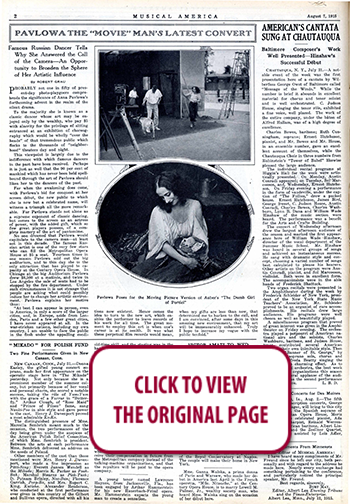 100 YEARS AGO...IN MUSICAL AMERICA (106)
100 YEARS AGO...IN MUSICAL AMERICA (106)
August 7, 1915
Page 2
PAVLOWA THE “MOVIE” MAN’S LATEST CONVERT
Famous Russian Dancer Tells Why She Answered the Call of the Camera—An Opportunity to Broaden the Sphere of Her Artistic Influence
By ROBERT GRAU
PROBABLY not one in fifty of present-day photo-playgoers comprehends the significance of Anna Pavlowa’s forthcoming advent in the realm of the silent drama.
To the majority she is known as a classic dancer whose art may be enjoyed only by the wealthy, who pay $5 with alacrity for the privilege of sitting entranced at an exhibition of choreography which would be wholly “over the heads” of that tremendous public which flocks to the thousands of “neighborhood” theaters day and night.
This viewpoint is largely due to the indifference with which famous dancers in the past have been received. Perhaps it is just as well that the 90 per cent of mankind which has never been held spellbound through the art of Pavlowa should liken her to the dancers of the past.
For when the awakening does come, with Pavlowa’s bid for conquest at .her screen debut, the new public to which she is now but a celebrated name, will witness a triumph all the more remarkable. For Pavlowa stands not alone as a supreme exponent of classic dancing, but comes to the screen as an actress of power, with the added gift, which so few great players possess, of a complete mastery of the art of pantomime.
No one dreamed that Pavlowa would capitulate to the camera man—at least not in this decade. The famous Russian artist is one of the very few stars who can fill the Metropolitan Opera House at $5 a seat. Fourteen times in one season Pavlowa sold out the big auditorium, and to this day she is the only attraction that has played to capacity at the Century Opera House. In Chicago at the big Auditorium Pavlowa drew $8,500 at a matinée, and twice in Los Angeles the sale of seats had to be stopped by the fire department. Under such circumstances it is not strange that people are asking what could possibly induce her to change her artistic environment. Pavlowa explains her motive thus:
“At best I can appear in person, even in America, in only a score of the larger cities, and, in Europe, aside from London, Paris and a few other great cities, I have never appeared at all. In the war-stricken nations, including my own country, I am unable to face the public in the flesh under the appalling conditions now existent. Hence comes the idea to turn to the new art, which enables the performer to leave records of his work for all time. The great moment to employ this art is when one’s career is at its zenith. It was what these perpetual film records would mean, when my gifts are less than now, that determined me to harken to the call, and I am convinced, after some days in this amazing new environment, that my art will be immeasurably enhanced. Truly I hope to increase my vogue with the public tenfold.”




 RENT A PHOTO
RENT A PHOTO





